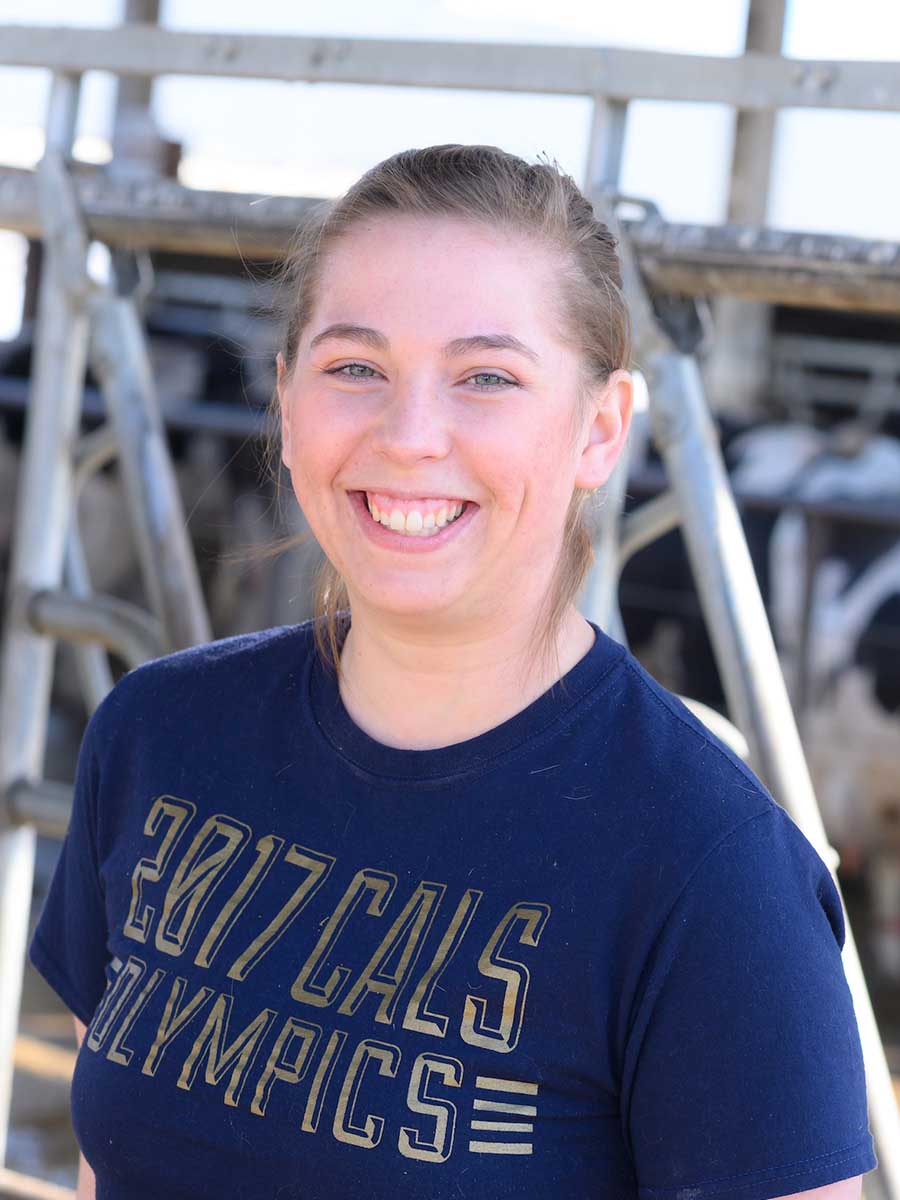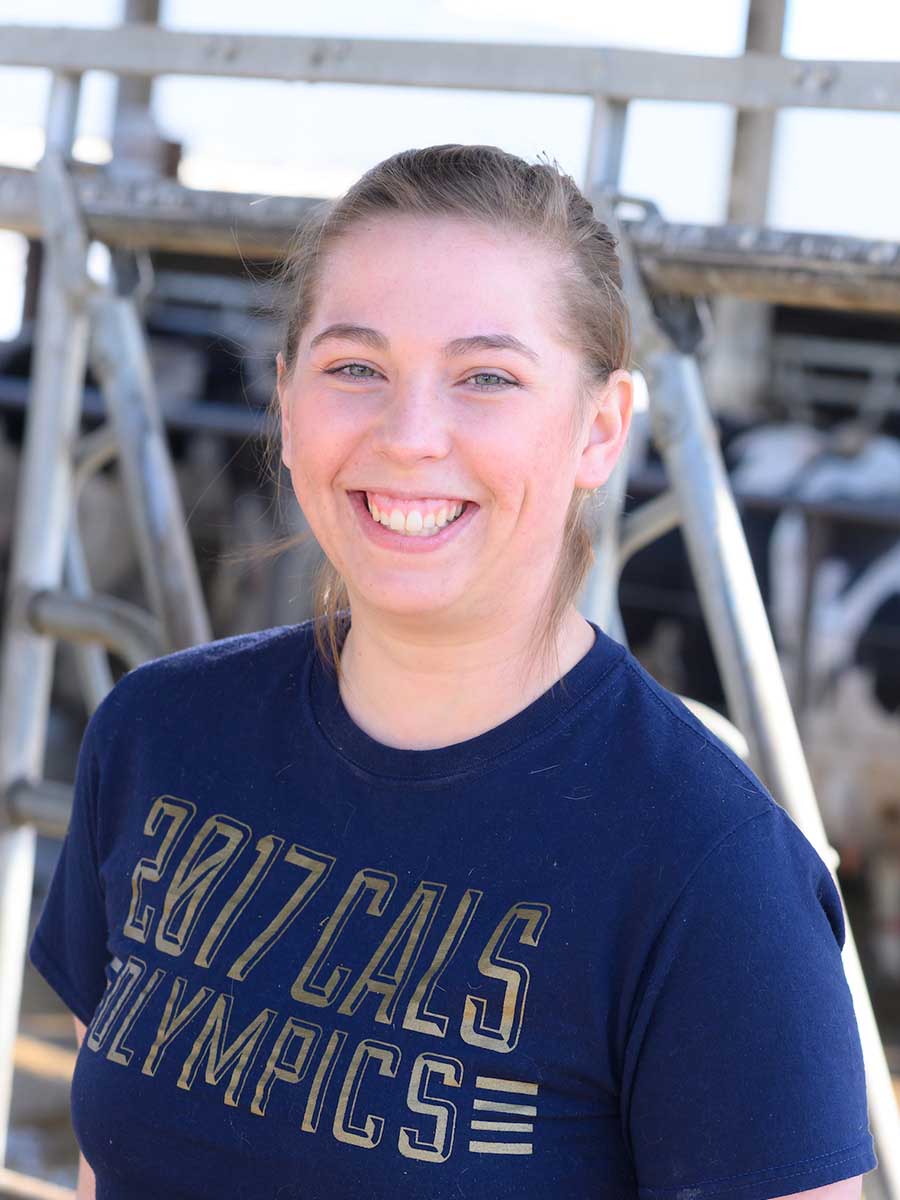Managing Dairy Nutrition
Animal and Veterinary Science student sets foundation for further research
As the world population continues to grow, so too does the demand for agricultural products — including dairy.
But an increase in milking cows has resulted in an increase in nitrogen emissions, one of the largest pollution issues surrounding the dairy industry.
Allison Stevens decided to tackle the issue as a graduate student at the University of Idaho. She presented her research at the 2019 Three-Minute Thesis/Three-Minute Masters competition held in Boise and earned a second place finish against other graduate students across Idaho. She graduates with a master’s degree in animal science in spring 2019 and has set the groundwork for further research on this complex topic.
Lowering Protein
Scientists and producers know that feeding dairy cows less protein results in less excess nitrogen and less nitrogen emissions. However, feeding less protein often results in a decrease in milk production.
U of I professors in the College of Agricultural and Life Sciences’ Department of Animal and Veterinary Science developed a proposal to study how to reduce protein while maintaining production. They recruited Stevens to lead the project following her 2017 graduation from U of I with a bachelor’s degree in animal and veterinary science: dairy science option.
“The premise of the study was increasing efficiency in dairy cattle for nitrogen use because of the environmental concerns but also the cost of feeding proteins,” Stevens said. “We were hoping to find that if you feed a lower protein diet but you supplement it with amino acids, you have less nitrogen excreted but you don’t lose production.”
Stevens conducted a four-month study with six Holstein cows from the U of I Dairy Center. Three cows were fed an industry standard diet that included high amounts of protein content. The other cows were fed 2 percent less protein. Cows on each diet were also fed one of two complimentary amino acid supplements.
“Ultimately, what we found when we lowered by 2 percent, we didn’t lose any production, there’s a lot less nitrogen in the urine, but the supplements didn’t seem to have a huge effect,” Stevens said. “The only difference in the feed was protein content. Statistically, the production was the same. There was some positive effect of the supplements but only on the blood concentration of protein.”
The study served as a pilot for U of I researchers to determine if further research is warranted on a larger scale.
“They’ll be looking into the supplements more because that’s the whole goal, to lower the protein even more, get rid of even more nitrogen waste and use these specific amino acids to target milk production and keep it up,” Stevens said.
Reducing the environmental impact is the main concern, but a reduced protein diet while maintaining the current milk production will also result in lower feed costs for producers.
“We want to prove definitively that if you supplement you don’t have to feed as much protein,” Stevens said. “It would save you more money and increase your profit margins if you just decreased your protein and then supplemented.”
Her research experience will serve her well after graduation as she seeks a position as a dairy nutritionist. In that role she will visit dairy farms and advise producers on how to mix their feed as well as what supplements and grains are needed to increase production and ensure the overall health of the herd.
“It’s a lot of chemistry and math, just applied,” Stevens said. “It’s not going to be difficult to find a job. I had job offers during my undergrad to be a nutritionist but they wanted me to move to the Midwest. So I decided to get a master’s, become more desirable so I can stay where I want to stay.”

Introduction to Dairy
Stevens grew up in Boise but did not have a traditional agriculture background. Her father is a retired firefighter and her mother works as a truss designer. Stevens decided to join FFA as a student at Mountain View High School in Meridian because she loved animals and was interested in becoming a veterinarian.
The FFA advisor at MVHS, Trish Stokes, encouraged Stevens to join FFA and participate in animal science projects. When Stevens decided she wanted to raise and show sheep in FFA, Stokes allowed her to house the animal on her farm.
“She saw the potential and got me interested,” Stevens said. “I had a huge opportunity for overall agriculture exposure through the Meridian FFA chapter.”
Stevens initially decided to enroll at U of I for her bachelor’s degree with the goal of becoming a large animal veterinarian.
“I always wanted to work with animals and if you want to go to school in Idaho and work with animals then the U of I is the place to go,” Stevens said. “It wasn’t a hard choice. I visited campus with FFA in high school and loved it.”
The Introduction to Dairy Science course taught by Animal and Veterinary Science Professor Amin Ahmadzadeh opened Stevens’ eyes to the dairy industry and prompted her to re-think her career goals.
“Amin is an excellent instructor, especially for young students, because he’s enthusiastic and helpful,” Stevens said. “That class is once a week and you have a lecture followed by a four-hour lab at the dairy. Immediately you are hands-on. You get to learn and experience working with the animals.”
Article by Amy Calabretta, College of Agricultural and Life Sciences
Published in April 2019
Allison Stevens is working on reducing the amount of nitrogen emissions produced by dairy cattle while maintaining milk production to meet the demands of a growing population.







